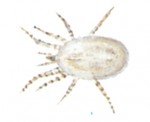

Several mite species live in and around bird nests. They seek out birds in the nests and suck their blood. Although the bird mites are small, their mouth parts are quite long. They pierce the skin using a pair of sharp claws. The long claws are usually hidden inside the body. If you want to see them, simply press on the mite’s stomach, and they are pushed out. The claws can penetrate 0.5 mm of the skin. The mites drink blood flowing from the wound. This inelegant way to feed is felt by the host. The most common bird mite in Denmark is the Dermanyssus gallinae, red mite, poultry mite, red poultry mite, roost mite and chicken mite. It can be a nuisance for hens, chickens and all sorts of caged birds. In the wild it is also found in pigeons, sparrows and many other different birds with dry, high-lying nests.
NB. The bird mites belong to a large group of mites (Gamaside) which are very similar in appearance. Almost all are free-living and peaceful. From time to time, they inhabit houses that are a little too damp, and can be confused with bird mites.
May attack people
If their normal hosts leave the nest the red mite will seek out other warm-blooded creatures – e.g. people. Usually, they are both seen and felt. The bite wounds may itch a little. As far as we know, the red mite is not a transmitter of diseases.
Changes color
Adults red mites are 1 mm long, flat and have 8 legs. Right after a blood meal, the mites are beautifully red. As the blood is digested, the mites are slightly smaller and the color turns gray or black. Mites that have not fed for a long time are almost whitish.




